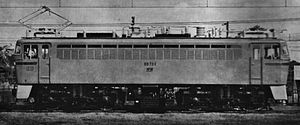| Class ED73 | |||||||||||||||||||||||||||
|---|---|---|---|---|---|---|---|---|---|---|---|---|---|---|---|---|---|---|---|---|---|---|---|---|---|---|---|
 The first locomotive delivered, ED73 1, in 1962 | |||||||||||||||||||||||||||
| |||||||||||||||||||||||||||
| |||||||||||||||||||||||||||
| |||||||||||||||||||||||||||
| |||||||||||||||||||||||||||
The Class ED73 (ED73形) was a Bo-Bo wheel arrangement AC electric locomotive type operated by Japanese National Railways (JNR) in Kyushu, Japan, between 1962 and the 1980s.[1]
Design
[edit]The Class ED73 design was broadly derived from the Class ED72 locomotives introduced a year earlier, but as the Class ED73 was primarily intended for use on freight services, it did not include a steam generator for train heating, and was therefore 3 m (9 ft 10 in) shorter than the Bo-2-Bo wheel arrangement Class ED72.[1] The DT119B bogies were also almost identical to those used on the full-production Class ED72 locomotives.[2]
History
[edit]A total of 22 locomotives were built by Toshiba between 1962 and 1963.[1] The first locomotives were delivered to Moji Depot in northern Kyushu.[2]
In the late 1960s, the entire class was modified with improved braking performance for use on express freight services, and the locomotives were renumbered in the ED73 10xx series.[1] The locomotive numbers were painted yellow at this time.[1] In later years, the class was also used on overnight sleeping car services, as these trains did not require steam heating.[1]
The class was withdrawn by the early 1980s.[1] No examples of the class have been preserved.[3]
Classification
[edit]The ED73 classification for this locomotive type is explained below.
- E: Electric locomotive
- D: Four driving axles
- 7x: AC locomotive with maximum speed exceeding 85 km/h (55 mph)
References
[edit]- ^ a b c d e f g Inoue, Koichi (1999). 国鉄機関車事典: 蒸気・電気・ディーゼル機関車66形式 国鉄機関車辞典 [JNR Locomotive Encyclopedia]. Japan: Sankaido. pp. 140–141. ISBN 978-4-381-10338-3.
- ^ a b Tezuka, Kazuyuki (January 1963). 交流電気機関車ED731 [AC electric locomotive ED73 1]. Japan Railfan Magazine (in Japanese). Vol. 3, no. 19. Japan: Koyusha Co., Ltd. p. 14.
- ^ Sasada, Masahiro (September 2012). 国鉄&JR保存車大全 [JNR & JR Preserved Rolling Stock Complete Guide]. Tokyo, Japan: Ikaros Publications Ltd. p. 126. ISBN 978-4863206175.

Well, that’s interesting to know that Psilotum nudum are known as whisk ferns. Psilotum nudum is the commoner species of the two. While the P. flaccidum is a rare species and is found in the tropical islands. Both the species are usually epiphytic in habit and grow upon tree ferns. These species may also be terrestrial and grow in humus or in the crevices of the rocks.
View the detailed Guide of Psilotum nudum: Detailed Study Of Psilotum Nudum (Whisk Fern), Classification, Anatomy, Reproduction